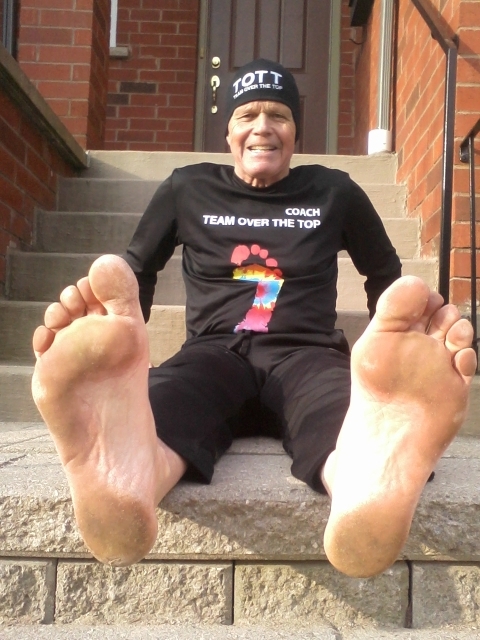As the temperature in my neighbourhood (Port Credit, Ontario, Canada) dropped to a rather chilly 2 degrees Celsius or 8 degrees Fahrenheit for a few days last week, the reality of another fast approaching winter running season dawned on me. It got me to thinking “I better get myself prepared for the inevitable ‘MINUS’ temperatures IF I wish to run barefoot outdoors this winter. There actually may also be a few of you thinking the same thing. Over the years, I have found a few techniques that help prepare my feet especially to the harsh conditions of winter in my ‘hood. They are as follows:
- I run on damp or wet grass areas (wet grass is much colder at this time of year than dirt, gravel, asphalt or concrete) for at least part of every early morning run
- I run through ANY puddles of standing water (best after an overnight rain) along my route for the same reason as above
- I stand, walk or run in the nearby lake, river and stream that all flow through my hometown. The average water temperature at this time of year is 5 to 10 degrees Celsius or 38 to 42 degrees Fahrenheit. If you are lucky enough to be near bodies of water, do the same thing as often as possible during your runs. If not, try to find at least a creek or stream that is near you. Again, failing that, do extra running on dew or rain-dampened grassy fields
- I go barefoot throughout my day as often as possible in the gradually colder temperatures. I find that this is great at toughening up the skin of my feet to the harsher temperatures, helping me to fend off frostbite and ice or salt stone cuts in the dead of winter
- I will try NOT to miss any early morning runs (5:30 a.m. is my usual start time) when the temperature is at its lowest point and the grass has the heaviest amount of moisture. This forces my body temperature to adapt and increase the flow of blood to my feet, thus keeping my toes alive and well and speeding up my transition to safe winter barefoot running
Whether you are a barefoot runner who has NEVER run barefoot in a cold winter, a runner who is transitioning to barefoot running or simply a runner who has gone to minimalist footwear, you will benefit from doing at least a few of the above activities barefoot. They will help you balance better, sense terrain changes better and centre better over your feet. For those still running in full-on ‘coffins’ (thick-heeled, thick-soled mega shoes) and not interested in running injury-free, good luck.
Coach Jeff







